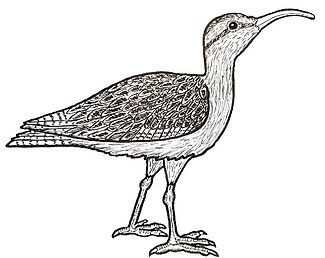Creature
Fast Facts
Introducing you to extinct species.

THE
ESKIMO CURLEW
1. The Eskimo curlew, Numenius borealis, was also known as the northern curlew. Numenius means “of a new moon”. Borealis means “northern”. 2. The Scolopacidae family includes curlews, woodcocks, sandpipers, and snipes. 3. The Eskimo curlew was once the most numerous shorebird in the Western Arctic of Alaska and Canada with a population in the millions. 4. It was 20 inches long and weighed 13 ounces. This curlew ate berries and insects including the now extinct Rocky Mountain locusts. 5. The Eskimo curlew had long dark gray legs and a long bill, less curved than other curlews. Light brown belly with brown blotches. 6. They have a 28 inch wingspan with cinnamon brown wing lining. The primary feathers are unbarred like other curlews. 7. The Eskimo curlew bulked up before its long migration. Its “fat” look gave rise to several nicknames like doughbird, fute (crafty), and prairie pigeon. 8. The Eskimo curlew migration was from the Yukon, across the Great Plains in the United States to their wintering grounds in Pampas, Argentina. 9. In June, the Eskimo curlew laid several green eggs with brown splotches on the ground, though not much is known about its actual nesting habits. 10. The last confirmed photo of an Eskimo curlew was taken in Galveston, Texas in the United States in 1962. A specimen was collected a year later in 1963 in Barbados. 11. A book called, Last of the Curlews was turned into an Emmy Awarded film in 1972.
Extinction
Cometh
Facing the light at the end of the tunnel
EXTINCTION DATE
1963
The Eskimo curlew once migrated from Alaska to Argentina. Its population is estimated to have been in the millions. The probable cause of its extinction began with the Westward Expansion in the United States. As the human population on the Great Plains went up, so did the hunts of this migratory shorebird. It is estimated that as many as 2 million Eskimo curlews were killed in the late 1800’s. As their numbers dwindled, the population of curlews became fragmented throughout its large migration route. The last confirmed photo of an Eskimo curlew was taken in 1962 in Galveston, Texas. One year later, a specimen was found in Barbados. Since then numerous unconfirmed sightings have been made in many places throughout the United States, Canada, Argentina, and Guatemala. It is possible that a small flock of 21 Eskimo curlew were seen in Texas in 1981, but that report was also unconfirmed. The Eskimo curlew is most likely extinct though still listed as "critically endangered” in most places. Although Jurassic Park is fiction, scientists are working on several de-extinction projects. In fact, in 2003 scientists did bring back the extinct Pyrenean ibex, a type of wild goat, for 7 minutes before it died, showing de-extinction is possible. The Eskimo curlew could be a candidate. Scientists would potentially use DNA from one of the 400 known specimens found in museums around the world. With a specimen as recently as 1963 found in Barbados, it may be possible to bring back this unique curlew species. The United States has made many strides in protecting endangered species through many initiatives like the US Endangered Species Act of 1972. Since 1972, many species including the California condor, American bison, bald eagle, black-footed ferret, and grizzly bear have been saved from risk of extinction. If the Eskimo curlew was brought back to life, would it be able to survive throughout its long migration route?
COMING
SOON
The Eskimo curlew's Lazarus tale has yet to be written, but what adventures will await it when it returns to its migration path throughout its historic range? Stay tuned to find out.
More to Explore
All answers lead to more questions
VIDEOS & ADDITIONAL INFO
Facts about the Eskimo Curlew
Eskimo Curlew Extinction Facts
The Last of the Curlews - 1972 - Video
Fascinating Facts about Curlews
U.S. Fish & Wildlife Service Information
Eurasian Curlew Facts from Birdorable
Facts About 8 Other Species of Curlew
Facts about the Slender-Billed Curlew

A photo by Don Bleitz from Galveston Island in 1962
Image from Wikipedia

16 Eskimo Curlew specimens
at the Smithsonian Institution
in Washington, D.C.
Image from Maryland
Biodiversity Project

Specimen in Laval University Library
Image from Wikipedia

Specimen from 1892 in Smithsonian Institute
Image from Maryland Biodiversity Project

John James Audubon Illustration of Eskimo curlew
Image from Wikipedia

The Eskimo Curlew Caricature
by Sam Georgieff
Image from Etsy

A migration map showing the yearly flight path of the Eskimo curlew
Image from Western Hemisphere Shorebird Reserve Network

The Eskimo Curlew by Charley Harper
Image from Etsy

Curlew Character
Image from Freepik

1 oz Silver Bar
Image from Numista

The Eskimo Curlew Statue in Galveston, Texas by Tim McGrain is part of "The Lost Birds Project"
Image from Galveston County Daily News

Hanna-Barbera's Emmy Nominated Children's Program
Image from The Movie Database

This book chronicles the last sightings of the Eskimo curlew through 1986
Image from Amazon

Eurasian curlew
Image from Birdorable

A long-billed curlew nest
Image from North Dakota Game and Fish

A long-billed curlew getting a transmitter to track its migration
Image from North Dakota Game and Fish

1902 Illustration of slender-billed curlew by Henrik Grønvold
Image from Wikipedia

1830 illustration from The Birds of Europe by Gould & Lear
Image from Wikipedia

Vieillot, 1817 - from the Naturalis Biodiversity Center
Image from Wikipedia

1902 Illustration by John Gerrard Keulemans of a group of curlews with the slender-billed curlew in the middle
Image from Wikipedia

Memorial artwork of the slender-billed curlew
Image from angelaknapp.co.uk



